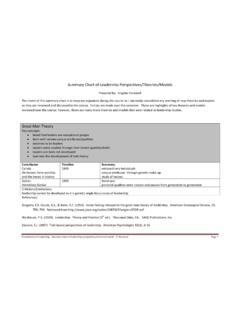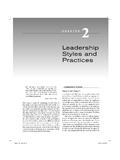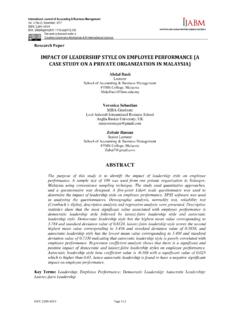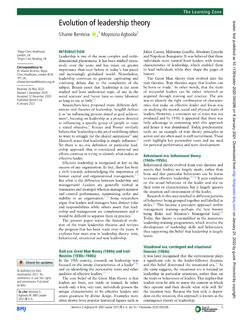Transcription of The Blake Mouton Managerial Grid - D. Cook Academic
1 IlluminationsSome leaders are very task-oriented; they simply want to get things done. Others are very people-oriented; they want people to be happy. And others are a combination of the two. If you prefer to lead by set-ting and enforcing tight schedules, you tend to be more production-oriented (or task-oriented). If you make people your priority and try to accommodate employee needs, then you are more preference is right or wrong, just as no one type of leadership style is best for all situations. How-ever, it is useful to understand what your natural lead- ership tendencies are, so that you can then work on developing skills that you might be popular framework for thinking about a leader s task versus person orientation was developed by Robert Blake and Jane Mouton in the early 1960s.
2 Called the Managerial grid , the leadership grid , or simply the Blake Mouton Managerial grid . It is a practical and useful framework that helps you think about your lead- ership style. It plots the degree of task-centeredness versus person-centeredness and identifies five combi-nations as distinct leadership plotting concern for production against concern for people , the grid highlights how placing too much emphasis in one area at the expense of the other leads to low overall productivity. The model proposes that when both people and pro-duction concerns are high, employee engagement and productivity increases accordingly. This is often true, and it follows the ideas of Theories X and Y, and other participative management theories. While the grid does not entirely address the complexity of Which leadership style is best?
3 , it certainly pro-vides an excellent starting place to critically analyze your own performance and improve your general lead- ership of the Blake Mouton Managerial GridIn the 1940s, in an attempt to identify the behavioral characteristics of successful leaders, Blake and Mou-The Blake Mouton Managerial GridIdentifying five different leadership stylesYou are in charge of a certain project, what do you do first?- Do you develop a time line and start assigning tasks?- Or do you think about who would prefer to do what and try to schedule around their needs?When the planning starts to fall behind schedule, what is your first reaction?- Do you chase everyone to get back on track?- Or do you ease off a bit recognizing that everyone is busy just doing his/her job, let alone the extra tasks you have assigned?
4 Your answers to these types of questions can reveal a great deal about your per-sonal leadership style. Prepared by: Hania Zeidan, LACPA 2009 3984 THE CERTIFIED ACCOUNTANT853rd Quarter 2009 Issuse #39 2009 3984 THE CERTIFIED ACCOUNTANT853rd Quarter 2009 Issuse #39 Illuminationston identified two fundamental drivers of Managerial behavior: the concern for getting the job done, and the concern for people doing the work. They argued that, on the one hand, an exclusive con-cern for production at the expense of the needs of those engaged in production, leads to dissatisfaction and conflict, thus adversely affecting performance; but that, on the other hand, an excessive concern to avoid conflict and maintain good relationships is also detri-mental to the achievement of goals and objectives.
5 In order to provide a framework for describing man-agement behaviors, the two variables of concern for production and concern for people were plotted on a grid showing nine degrees of concern for each, from 1 indicating a low level of concern, to 9 indicating a high level of concern. Five positions on the grid represent five differing Managerial behavior patterns. The concept distinguishes 5 different leadership styles, based on the concern for people and the concern for production:1. The Impoverished or the Indifferent Style )1,1( (Low Production / Low People) A delegate-and-disappear management style. A basi-cally lazy approach. The manager shows a low concern for both people and production. He (or she) avoids get-ting into trouble.
6 His main concern is not to be held re-sponsible for any mistakes. Managers use this style to preserve job and job seniority, protecting themselves by avoiding getting into trouble. As a result, disorgani-zation, dissatisfaction and disharmony due to lack of effective leadership are present. 2. Country Club Style (Low Production / High Peo-ple) One-sided, thoughtful attention to the needs of em-ployees. The relationship-oriented manager has a high concern for people, but a low concern for pro-duction. He pays much attention to the security and comfort of the employees. He hopes that this will in-crease performance. He is almost incapable of em-ploying the more punitive, coercive and legitimate powers. This inability results from fear that using such powers could jeopardize relationships with the other team members.
7 The organization will end up to be a friendly atmosphere, but not necessarily very productive. 3. Produce, Dictatorial or Perish Style )9,1( (High Production / Low People) An authoritarian or compliance leader. A task-oriented manager, he has a high concern for production and a low concern for people. He finds employee needs un-important and simply a means to an end. He provides his employees with money and expects performance back. There is little or no allowance for cooperation or collaboration. He pressures his employees through rules and punishments to achieve the company goals. Heavily task-oriented people are very strong on sched-ules. They are intolerant of what they see as dissent (it may just be someone s creativity). This dictatorial style is based on Theory X of Douglas McGregor.
8 It is often applied by companies on the edge of real or perceived failure, such as in Crisis this case, whilst high output is achievable in the short term, much will be lost through an inevitable high labor turnover. 2009 3984 THE CERTIFIED ACCOUNTANT853rd Quarter 2009 Issuse #39 2009 3984 THE CERTIFIED ACCOUNTANT853rd Quarter 2009 Issuse #39 Illuminations4. The Middle-of-the-road or The Status-quo Style )5,5( (Medium Production / Medium People). Balance and compromise. The manager tries to bal-ance between the competing goals of the company and the needs of the workers. The manager gives some concern to both people and production, hoping to achieve acceptable performance.
9 He believes this is the most anyone can do. Consequently, compromis-es occur where neither the production nor the people needs are fully met. 5. The Team or Sound Style )9,9( (High Production / High People). Contribute and commit. It is the ultimate. The manager pays high concern to both people and production. Moti-vation is high. This soft style is based on the propositions of Theory Y of Douglas McGregor. The manager encour-ages teamwork and commitment among employees. This style emphasizes making employees feel part of the company-family, and involving them in understand-ing organizational purpose and determining production needs. This method relies heavily on making employees feel they are constructive parts of the company. And this will result in a team environment organization based on of the Blake Mouton Managerial GridBeing aware of the various approaches is the first step in understanding and improving how well the manager performance is.
10 It is important to understand how you currently operate, so that you can then identify ways of becoming competent in both realms. Step One: Identify your leadership Think of some recent situations where you were the leader. - For each of these situations, place yourself in the grid according to where you believe you fit. Step Two: Identify areas of improvement and develop your leadership skills- Look at your current leadership method and critically analyze its effectiveness. - Look at ways you can improve. Are you settling for middle of the road because it is easier than reaching for more? - Identify ways to get the skills you need to reach the Team leadership position. These may include involv-ing others in problem solving or improving how you communicate with them, if you feel you are too task-oriented.










